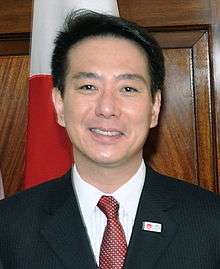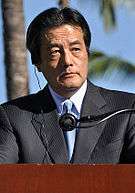History of the Democratic Party of Japan
History of the Democratic Party of Japan (DPJ).
History
Beginnings
.jpg)
The Democratic Party of Japan (DPJ) was formed on 27 April 1998.[1] It was a merger of four previously independent parties that were opposed to the ruling Liberal Democratic Party (LDP)—the previous Democratic Party of Japan, the Good Governance Party (民政党, Minseitō), the New Fraternity Party (新党友愛, Shintō-Yuuai), and the Democratic Reform Party (民主改革連合, Minshu-Kaikaku-Rengō). These were all new parties that were either liberal or social-democratic. The new party began with ninety-three members of the House of Representatives and thirty-eight members of the House of Councilors. Moreover, the party officials were elected as well at the party convention for the first time; Naoto Kan, former Health and Welfare Minister was appointed as the president of the party and Tsutomu Hata, former Prime Minister as Secretary-General.
On 24 September 2003 the party formally merged with the small, centre-right Liberal Party led by Ichirō Ozawa[2]—the move was largely considered to be done in preparation for the election on 9 November 2003. This move immediately gave the DPJ eight more seats in the House of Councilors.
In the 2003 general election the DPJ gained a total of 178 seats. This was short of their objectives, but nevertheless a significant demonstration of the new group's strength. Following a pension scandal, Naoto Kan resigned and was replaced with a moderate liberal—Katsuya Okada.
In the 2004 House of Councilors elections, the DPJ won a seat more than the ruling Liberal Democrats, but the LDP still maintained its firm majority in total votes. This was the first time since its inception that the LDP had garnered fewer votes than another party.
The 2005 snap parliamentary elections called by Junichiro Koizumi in response to the rejection of his Postal privatization bills saw a major setback to the DPJ's plans of obtaining a majority in the Diet. The DPJ leadership, particularly Okada, had staked their reputation on winning the election and driving the LDP from power. When the final results were in, the DPJ had lost 62 seats, mostly to its rival the LDP. Okada resigned the party leadership, fulfilling his campaign promise to do so if the DPJ did not obtain a majority in the Diet. He was replaced by Seiji Maehara in September 2005.
However, Maehara's term as party leader lasted barely half a year. Although he initially led the party's criticism of the Koizumi administration, particularly in regards to connections between LDP lawmakers and scandal-ridden Livedoor, the revelation that a fake email was used to try and establish this link greatly damaged his credibility. The scandal led to the resignation of Representative Hisayasu Nagata and of Maehara as party leader on 31 March.[3] New elections for party leader were held on 7 April, in which Ichirō Ozawa was elected President.[4] In Upper House election 2007, the DPJ won 60 out of 121 contested seats, with 49 seats not up for re-election.
2009-present

Ozawa resigned as party leader in May 2009 after a fundraising scandal and Yukio Hatoyama succeeded Ozawa before the 2009 general election.[1] The DPJ swept the LDP from power in a massive landslide, winning 308 seats (out of a total of 480 seats), while the LDP won only 119 seats[5][6] - the worst defeat for a sitting government in modern Japanese history. This was in marked contrast to the 1993 election, the only other time the LDP has lost an election.
The DPJ won a strong majority in the House of Representatives, thus virtually assuring that Hatoyama will be the next prime minister. Under the Constitution, if the House of Representatives and the House of Councilors cannot agree on a choice for prime minister, the choice of the House of Representatives is deemed to be that of the Diet. Hatoyama was nominated as prime minister on September 16 and formally appointed later that day by Emperor Akihito.
However, the DPJ was just short of a majority in the House of Councillors, and fell just short of the 320 seats (a two-thirds majority) needed to override negative votes in the upper chamber. Hatoyama was thus forced to form a coalition government with the Social Democratic Party and the People's New Party.[7]
On 2 June 2010, Hatoyama announced his resignation before a party meeting. He cited breaking a campaign promise to close an American military base on the island of Okinawa as the main reason for the move. On 28 May 2010, soon after and because of increased tensions after the possible sinking of a Korean ship by North Korea,[8] Hatoyama had made a deal with U.S. President Barack Obama[9][10][11][12][13] to retain the base for security reasons, but the deal was unpopular in Japan. He also mentioned money scandals involving a top party leader, Ozawa, who resigned as well, in his decision to step down.[9] Hatoyama had been pressured to leave by members of his party after doing poorly in polls in anticipation of an July upper house election.[14] President of DPJ and Prime Minister Hatoyama announced that he would be resigning. He ended his service as President of the DPJ and Prime Minister on 4 June. Naoto Kan succeeded Hatoyama as the next President of DPJ and Prime Minister of Japan.[15]
Presidents of DPJ
The Presidents of Democratic Party of Japan (ja:民主党代表 Minshutō Daihyō), the formal name is 民主党常任幹事会代表 (Minshutō Jyōnin-Kanji-Kai Daihyō).
| No. | Name | Term of office | Image | Election results | |
|---|---|---|---|---|---|
| Took office | Left office | ||||
| 1 | Naoto Kan 菅 直人 Kan Naoto |
27 April 1998 | 18 January 1999 |  |
unchallenged |
| 18 January 1999 | 25 September 1999 | Naoto Kan - 180 Shigefumi Matsuzawa - 51 Abstention - 8 | |||
| 2 | Yukio Hatoyama 鳩山 由紀夫 Hatoyama Yukio |
25 September 1999 | 9 September 2000 |  |
Yukio Hatoyama - 182 Naoto Kan - 130 |
| 9 September 2000 | 23 September 2002 | walkover | |||
| 23 September 2002 | 10 December 2002 | Yukio Hatoyama - 254 Naoto Kan - 242 | |||
| 3 | Naoto Kan 菅 直人 Kan Naoto |
10 December 2002 | 18 May 2004 |  |
Naoto Kan - 104 Katsuya Okada - 79 |
| 4 | Katsuya Okada 岡田 克也 Okada Katsuya |
18 May 2004 | 13 September 2004 |  |
unchallenged |
| 13 September 2004 | 17 September 2005 | walkover | |||
| 5 | Seiji Maehara 前原 誠司 Maehara Seiji |
17 September 2005 | 7 April 2006 |  |
Seiji Maehara - 96 Naoto Kan - 94 Abstention - 3 |
| 6 | Ichirō Ozawa 小沢 一郎 Ozawa Ichirō |
7 April 2006 | 12 September 2006 |  |
Ichirō Ozawa - 119 Naoto Kan - 73 |
| 12 September 2006 | 21 September 2008 | walkover | |||
| 21 September 2008 | 16 May 2009 | walkover | |||
| 7 | Yukio Hatoyama 鳩山 由紀夫 Hatoyama Yukio |
16 May 2009 | 4 June 2010 |  |
see 2009 election Yukio Hatoyama - 124 Katsuya Okada - 95 |
| 8 | Naoto Kan 菅 直人 Kan Naoto |
4 June 2010 | 14 September 2010 |  |
see Jun 2010 election Naoto Kan - 291 Shinji Tarutoko - 129 |
| 14 September 2010 | 29 August 2011 | see Sep 2010 election Naoto Kan - 721 Ichirō Ozawa - 491 | |||
| 9 | Yoshihiko Noda 野田 佳彦 Noda Yoshihiko |
29 August 2011 | 21 September 2012 |  |
see 2011 election Yoshihiko Noda - 215 Banri Kaieda - 177 |
| 21 September 2012 | 25 December 2012 | Yoshihiko Noda - 818 Hirotaka Akamatsu - 154 Kazuhiro Haraguchi - 123 Michihiko Kano - 113 | |||
| 10 | Banri Kaieda 海江田 万里 Kaieda Banri |
25 December 2012 | 14 December 2014 | Banri Kaieda - 90 Sumio Mabuchi - 54 | |
| 11 | Katsuya Okada 岡田 克也 Okada Katsuya |
14 December 2014 | 18 January 2015 |  |
acting |
| 18 January 2015 | incumbent | see 2015 election | |||
References
- 1 2 FACTBOX: Key facts about parties competing in Japan election, Reuters, 20 August 2009
- ↑ "The Democratic Party of Japan". Democratic Party of Japan. 2006. Retrieved 2008-09-06.
- ↑ Japan opposition leader resigns, BBC NEWS, 31 March 2006
- ↑ Japanese opposition picks leader, BBC NEWS, 7 April 2006
- ↑ "'Major win' for Japan opposition". BBC News. 2009-08-30. Retrieved 2009-08-31.
- ↑ "衆院党派別得票数・率(比例代表)". (in Japanese) Jiji. 2009-08-31.
- ↑ "Hatoyama says DPJ will form coalition even if party performs well in election". Mainichi. 2009-08-22.
- ↑ Associated, The (2010-05-23). "Japan's Leader Concedes To U.S. On Okinawa Base". NPR. Archived from the original on 2010-05-25. Retrieved 2010-06-02.
- 1 2 Hayashi, Yuka (2 June 2010). "Japanese Prime Minister Yukio Hatoyama Resigns; Search for New Leader Begins - WSJ.com". Online.wsj.com. Retrieved 2010-06-02.
- ↑ "MCAS Futenma to remain on Okinawa". Marine Corps Times.
- ↑ "Hatoyama, Obama to talk on Futenma Air Base: report". Reuters. 25 May 2010. Retrieved 2010-06-02.
- ↑ The Yomiuri Shimbun. "'Obama nod' prompted Fukushima dismissal : National : DAILY YOMIURI ONLINE (The Daily Yomiuri)". Yomiuri.co.jp. Archived from the original on 2010-06-05. Retrieved 2010-06-02.
- ↑ "Obama, Hatoyama Satisfied With US Airbase Relocation - White House - WSJ.com". Online.wsj.com. 2010-05-27. Retrieved 2010-06-02.
- ↑ Linda Sieg and Yoko Nishikawa (2 June 2010). "Japan PM quits before election, yen sinks". Reuters. Retrieved 2010-06-02.
- ↑ reuters Japan Democrats pick heavyweight Kan as next PM